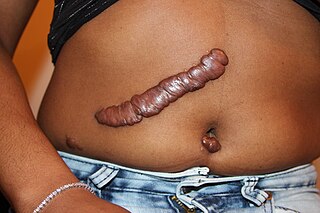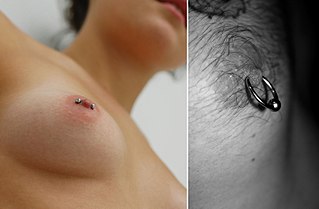Related Research Articles

Pediatrics also spelled paediatrics or pædiatrics, is the branch of medicine that involves the medical care of infants, children, adolescents, and young adults. In the United Kingdom, pediatrics covers many of their youth until the age of 18. The American Academy of Pediatrics recommends people seek pediatric care through the age of 21, but some pediatric subspecialists continue to care for adults up to 25. Worldwide age limits of pediatrics have been trending upward year after year. A medical doctor who specializes in this area is known as a pediatrician, or paediatrician. The word pediatrics and its cognates mean "healer of children", derived from the two Greek words: παῖς and ἰατρός. Pediatricians work in clinics, research centers, universities, general hospitals and children's hospitals, including those who practice pediatric subspecialties.

The Prince Albert (PA) is a penis piercing which extends from the urethra to the underside of the glans. It is one of the most common male genital piercings. The related reverse Prince Albert piercing enters through the urethra and exits through a hole pierced in the top of the glans.

A lip piercing is a type of body piercing that penetrates the lips or the area surrounding the lips, which can be pierced in a variety of ways.

Scarification involves scratching, etching, burning/branding, or superficially cutting designs, pictures, or words into the skin as a permanent body modification or body art. The body modification can take roughly 6–12 months to heal. In the process of body scarification, scars are purposely formed by cutting or branding the skin by various methods. Scarification is sometimes called cicatrization.

A navel piercing is a type of piercing that penetrates the skin of the navel. It is most commonly located on the upper fold of skin but can also be affected underneath or around the edges of the navel. Healing usually takes around 6–12 months but varies person-to-person due to differences in physiology.

Keloid, also known as keloid disorder and keloidal scar, is the formation of a type of scar which, depending on its maturity, is composed mainly of either type III (early) or type I (late) collagen. It is a result of an overgrowth of granulation tissue at the site of a healed skin injury which is then slowly replaced by collagen type I. Keloids are firm, rubbery lesions or shiny, fibrous nodules, and can vary from pink to the color of the person's skin or red to dark brown in color. A keloid scar is benign and not contagious, but sometimes accompanied by severe itchiness, pain, and changes in texture. In severe cases, it can affect movement of skin. In the United States, keloid scars are seen 15 times more frequently in people of sub-Saharan African descent than in people of European descent. There is a higher tendency to develop a keloid among those with a family history of keloids and people between the ages of 10 and 30 years.

Nose piercing is the piercing of the skin or cartilage which forms any part of the nose, normally for the purpose of wearing jewelry, called a nose-jewel. Among the different varieties of nose piercings, the nostril piercing is the most common.

An earring is a piece of jewelry attached to the ear via a piercing in the earlobe or another external part of the ear, or, less often, by some other means. Earrings have been worn in diverse civilizations and historic periods, often carrying a cultural significance.

Genital piercing is a form of body piercing that involves piercing a part of the genitalia, thus creating a suitable place for wearing different types of jewellery. Nevertheless, the term may also be used pars pro toto to indicate all body piercings in the area of the anus, perineum, penis, scrotum, and vulva, including piercings such as anal, guiche, and pubic that do not involve perforation of genitalia. Genital piercings can be done regardless of sex, with various forms of piercings available. The main motive is beautification and individualization; in addition, some piercings enhance sexual pleasure by increasing stimulation. Pre-modern genital piercings is most culturally widespread in Southeast Asia, where it has been part of traditional practice since ancient times. Records of genital piercing are found in the Kama Sutra.

A hafada piercing is a surface piercing anywhere on the skin of the scrotum. Piercings on the scrotal raphe or "seam" of the scrotum are common. This piercing does not penetrate deep into the scrotum, and due to the looseness and flexibility of the skin in that area, does not migrate or reject as much as many other surface piercings. The main motives are beautification and individualization. A piercing that passes through the scrotum, from front-to-back, or from side-to-side, is known as a transscrotal piercing. Multiple hafada piercings are not uncommon, often as an extension of a frenum ladder or Jacob's Ladder, which is a series of piercings from the frenulum to the scrotum.

A nipple piercing is a type of body piercing, centered usually at the base of the nipple. It can be pierced at any angle but is usually done horizontally or, less often, vertically. It is also possible to place multiple piercings on top of one another.

An ear-piercing instrument is a device designed to pierce earlobes by driving a pointed starter stud through the lobe. Piercing guns are typically used for ear piercing in mall jewelry shops, beauty salons, pharmacies, and doctors' offices.

Baby colic, also known as infantile colic, is defined as episodes of crying for more than three hours a day, for more than three days a week, for three weeks in an otherwise healthy child. Often crying occurs in the evening. It typically does not result in long-term problems. The crying can result in frustration of the parents, depression following delivery, excess visits to the doctor, and child abuse.
Stretching, in the context of body piercing, is the deliberate expansion of a healed piercing for the purpose of wearing certain types of jewelry. Ear piercings are the most commonly stretched piercings, with nasal septum piercings, tongue piercings and lip piercings/lip plates following close behind. While all piercings can be stretched to some degree, cartilage piercings are usually more difficult to stretch and more likely to form hypertrophic scars if stretched quickly. Dermal punching is generally the preferred method for accommodating larger jewelry in cartilage piercings.

Piercing migration is the process that occurs when a body piercing moves from its initial location. This process can be painful or go unnoticed, until it has progressed. Given enough time, a ring may migrate entirely outside of the skin, although it may only migrate a small amount and come to rest.

The human earlobe, the lower portion of the outer ear, is composed of tough areolar and adipose connective tissues, lacking the firmness and elasticity of the rest of the auricle. In some cases the lower lobe is connected to the side of the face. Since the earlobe does not contain cartilage it has a large blood supply and may help to warm the ears and maintain balance. However, earlobes are not generally considered to have any major biological function. The earlobe contains many nerve endings, and for some people is an erogenous zone.

An orbital piercing is a combination of two ear piercings connected by one piece of jewelry. While usually located in the helix region of the ear, an orbital piercing can be done anywhere on the body including the earlobes. The piercing uses a hoop, and is not to be confused with an industrial piercing, a conch piercing or double cartilage piercing.

A plug, in the context of body modification, is a short, cylindrical piece of jewelry commonly worn in larger-gauge body piercings. Modern western plugs are also called flesh tunnels. Because of their size—which is often substantially thicker than a standard metal earring—plugs can be made out of almost any material. Acrylic glass, metal, wood, bone, stone, horn, glass, silicone or porcelain are all potential plug materials.

Body piercing, which is a form of body modification, is the practice of puncturing or cutting a part of the human body, creating an opening in which jewellery may be worn, or where an implant could be inserted. The word piercing can refer to the act or practice of body piercing, or to an opening in the body created by this act or practice. It can also, by metonymy, refer to the resulting decoration, or to the decorative jewelry used. Piercing implants alter the body and/or skin profile and appearance. Although the history of body piercing is obscured by popular misinformation and by a lack of scholarly reference, ample evidence exists to document that it has been practiced in various forms by both sexes since ancient times throughout the world. Body piercing can be performed on people of all ages, although most minors are only permitted to have earlobe piercings.
A variety of health effects can result from tattooing. Because it requires breaking the skin barrier, tattooing carries inherent health risks, including infection and allergic reactions. Modern tattooists reduce such risks by following universal precautions, working with single-use disposable needles, and sterilising equipment after each use. Many jurisdictions require tattooists to undergo periodic bloodborne pathogen training, such as is provided through the Red Cross and the U.S. Occupational Safety and Health Administration.
References
- ↑ Fijalkowska, Marta; Pawel, Pisera; Kasielska, Anna; Antoszewski, Boguslaw (2011). "Should we say no to body piercing in children? Complications after ear piercing in children". International Journal of Dermatology. 50 (4): 467–469. doi:10.1111/j.1365-4632.2010.04778.x. PMID 21413962. S2CID 25773312.
- ↑ "Indians, Hispanics and Nigerians defend Kylie Jenner over baby's pierced ears". BBC News. July 19, 2018.
- ↑ Marcer, Hilary; Finlay, Fiona; Jordan, Natasha (2006). "Body piercing in school children: a review of the issues". Community Practitioner. 79 (10): 328–330. PMID 17061664.
- ↑ Peters, Terri (12 June 2015). "Petition aims to ban baby ear piercing". Today Parents.
- ↑ Macgregor, D.M. (2001). "The risks of ear piercing in children". Scottish Medical Journal. 46 (1): 9–10. doi:10.1177/003693300104600104. PMID 11310362. S2CID 37742154.
- ↑ Wellener, Mary Ann (2013). "Piercing baby's ears a parent's prerogative". Pittsburgh Post – Gazette. ProQuest 1266995751.
- ↑ Urist, Jacoba (14 January 2013). "Cute or cruel? Parents debate whether it's ok to pierce babies' ears". Today Parents.
- ↑ Kale, Satish; Patil, Surendra; Jaiswal, Sumeet; Khare, Nishant (2010). "A novel technique of piercing ears". Indian Journal of Plastic Surgery. 43 (2): 230. doi: 10.4103/0970-0358.73475 . PMC 3010795 . PMID 21217993.
- ↑ Dennis, Zach. "Petition looks to make baby ear piercing illegal". KRMG News. Archived from the original on 2016-03-04. Retrieved 2015-10-28.
- ↑ von Baeyer, Carl; Carlson, Gisele; Webb, Louise (1997). "Underprediction of pain in children undergoing ear piercing". Behaviour Research and Therapy. 35 (5): 399–404. doi:10.1016/s0005-7967(96)00127-1. PMID 9149448.
- ↑ Poe, Susannah; Cronin, Anne (2014). "Health risks associated with tattoos and body piercing". Journal of Clinical Outcomes Management. 21 (7): 315–320.
- ↑ Roberts, TA; Auinger, P; Ryan, SA (2004). "Body piercing and high-risk behavior in adolescents". J Adolesc Health. 34 (3): 224–229. doi:10.1016/j.jadohealth.2003.06.005. PMID 14967346.
- ↑ Braithwaite, Ronald; Stephens, Torrance; Sterk, Claire; Braithwaite, Keisha (1999). "Risks associated with tattooing and body piercing". Journal of Public Health Policy. 20 (4): 459–470. doi:10.2307/3343131. JSTOR 3343131. PMID 10643171. S2CID 2973823.
- ↑ Stapleton, F Bruder (2004). "Infection after ear piercing". Pediatrics and Adolescent Medicine.
- ↑ Cicchetti, S; Skillman, J; Gault, D (2002). "Piercing the upper ear: a simple infection, a difficult reconstruction". British Journal of Plastic Surgery. 55 (3): 194–197. doi: 10.1054/bjps.2001.3799 . PMID 12041970.
- ↑ Fors, Ronny; Stenberg, Berndt; Stenlund, Hans; Maurits, Persson (2012). "Nickel allergy in relation to piercing and orthodontic appliances – a population study". Contact Dermatitis. 67 (6): 342–350. doi:10.1111/j.1600-0536.2012.02097.x. PMID 22631615. S2CID 13427869.
- ↑ Berg, Paul (1986). "Ear piercing can spark allergy to metals".
- ↑ Hochman, Bernardo; Isoldi, Felipe; Silveira, Tiago; Borba, Graizela; Ferreira, Lydia (2015). "Does ear keloid formation depend on the type of earrings or piercing jewelry?". Australasian Journal of Dermatology. 56 (3): 77–79.
- ↑ Bhat, Vadisha (2014). "Ear piercing: the sad story behind ear lobule keloid". International Journal of Health and Allied Sciences. 3 (3): 210. doi: 10.4103/2278-344x.138612 .